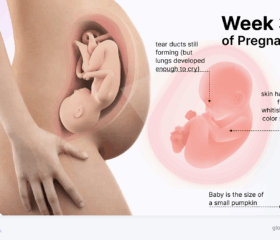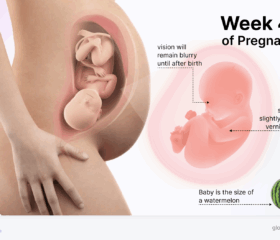What Do Labor Contractions Feel Like?
Childbirth is a notoriously painful and exhausting experience, and it’s natural if the thought of labor contractions makes you nervous.

Contractions are one of the most important signs that your baby is ready to meet the world. Because everyone’s experiences during pregnancy are different, it can be difficult to predict exactly how your contractions will feel and how to recognize them.
Read on to learn what contractions feel like, how they change during the stages of labor, and what signs of complications you should watch out for.
What do true labor contractions feel like?
There’s no single way to describe the sensation of contractions. You may feel pain primarily in your pelvic area, though it could also extend to your lower back or radiate down your thighs. 1
Many women feel contractions as:
- Intense cramping: Many women compare contractions to severe menstrual cramps, which can be dull or sharp and stabbing.
- Tightening: You may feel your abdomen “tightening” or hardening. This is because the uterus is constricting at the top to push your baby downward. 2
- Pressure: A feeling of pressure, often described as feeling like you need to have a bowel movement, is common, especially as the baby descends and pushes on the rectum. 3
- Back and belly pain: You may have pain or cramping in the lower back, or pain that radiates up to the upper belly. 4 5
- Burning: You may feel a burning sensation between your vagina and anus, particularly during crowning. 6
A lot of women describe contractions as having a wave-like pattern. The pain gradually builds, peaks, and then subsides, providing a period of relief before the next contraction begins. 7
What to know about back labor
Unfortunately, some women also experience a severe form of back pain during labor, known as back labor.
This generally happens if your baby is in an unusual position for labor, with the back of her head pressing against your spine. This puts pressure on your bones and spinal nerves.
While you’ll normally get a little relief between your labor contractions, with back labor, the pain is usually constant.
How to tell the difference between contractions and your baby moving
When you have contractions, usually your entire belly hardens and cramps. It’s also possible you’ll feel the top of your belly harden, or you’ll feel your contractions in the back, which is known as “back labor.”
Conversely, when you feel your baby kicking, you’ll usually feel a more localized hard area (e.g., if her butt or a limb puts pressure on your uterus). 8
How moms on Glow describe their contractions
As you can tell, contractions feel different for every mom-to-be. Check out what moms on Glow have to say about their contractions:
- “Contractions will be like period cramps, but 100% worse. They will stop you in your tracks.” 9
- “It’s kind of a radiating pain. Like a wave. It starts as your uterus tightens and fades away as it loosens back up.” 10
- “Pain that probably will stop you your tracks. Then you’ll get a moment of relief. Then bam! Another one. Repeat a bazillion times.” 10
- “Feels like cramps at first.” 10
- “Contracting usually wrap around your body toward the front, come in as a wave (meaning they build in intensity, like a wave cresting) and then you get a break, and they usually push downward in your uterus.” 11
- “Contractions is more lower belly. I started having them every 30 min, then 15, then 8…” 11
What’s the difference between Braxton Hicks contractions and true labor contractions?
Braxton Hicks contractions, often referred to as “practice contractions” or “false labor,” can occur throughout your pregnancy, though they usually show up in your second or third trimester. They’re typically irregular and painless. 4
Unlike Braxton Hicks, true labor contractions are coordinated muscle contractions of the uterus. They progressively open the cervix (cervical dilation), allowing your baby to pass through the birth canal. They become increasingly stronger and more frequent as labor progresses.
To tell the difference between Braxton Hicks contractions and true labor contractions, check out the table below:
| Feature | Braxton Hicks contractions | True labor contractions |
|---|---|---|
| Regularity | - Irregular - Unpredictable |
- Regular - Become more frequent |
| Intensity | - Mild - Don’t increase in intensity |
- More intense - Increase in intensity |
| Duration | - Short - Don’t get longer |
- Last longer - Get longer over time |
| Effect of activity | - Often subside with change in activity or position | - Continue regardless of position or activity |
| Cervical dilation | - No dilation or effacement | - Lead to dilation and effacement |
If you want extra clarity on your contractions, try using a pregnancy tracker app to time them so you’ll know when it’s time to get to the hospital.
Other signs of labor to look out for
Along with frequency and intensity of contractions, keep an eye out for the other signs of labor: 4
- Diarrhea: If you have looser stools and an increased feeling of urgency to go to the bathroom, those can be early labor signs. Be sure to drink plenty of water to make up for the lost fluids.
- Bloody show: Brown or bloody pregnancy discharge may indicate that you’ve lost your mucus plug (the thick barrier that protects your baby). For some women, this can happen days or weeks before labor, but others go into labor just a few hours after losing their mucus plug.
- Water breaking: When your amniotic sac (the bag of fluid that encases your baby) ruptures, you’ll feel a gush or steady stream of fluid leaking from your vagina.
Follow the “5-1-1” rule for contractions
For an easy shorthand, follow the 5-1-1 rule: if you have contractions every 5 minutes that last 1 minute each for a period of at least 1 hour, go to the hospital. 7
What to expect from your contractions during each stage of labor
The intensity, duration, and frequency of your contractions will change as you progress through each stage of labor. 12 7 13 14 15
The stages are described in the table below. Note that the timeline given is just an approximation; your own experience of labor might be different.
| Stage of labor | Duration of this stage | What happens at this stage | How contractions feel | Duration of each contraction | Frequency of contractions |
|---|---|---|---|---|---|
| Early labor | 6–12 hours | - Cervix begins dilating (widening) and effacing (thinning) | - Like strong menstrual cramps - Tightening in abdomen or lower back - May not initially be recognizable as contractions |
30–60 seconds | 5–20 minutes apart |
| Active labor | 4–8 hours | - Cervix dilates more quickly (this is when most women head to the hospital) | - More intense pain - May require pain relief |
40–60 seconds | 3–5 minutes apart |
| Transition | 15 minutes to 1 hour | - Cervix dilates from 8–10 cm - You may have the urge to push |
- Very intense pain | 60–90 seconds | A few minutes apart |
| Pushing and delivery | 30 minutes to 1 hour | - Cervix is fully dilated - You’ll actively push your baby |
- Intense, but more manageable | 60–90 seconds | 2–5 minutes apart |
Once your baby is born, you’ll continue to experience contractions as you pass your placenta. This will last 5 to 30 minutes after delivery.
What causes labor contractions?
Exactly what causes labor contractions is still a mystery, but hormones released by your baby may trigger them.
Certain chemicals produced by the mother also play a role, notably oxytocin and prostaglandins, both of which may be used by your doctor to induce labor and strengthen contractions. 16 17
Should you worry if you get contractions after sex?
Orgasms prompt the release of oxytocin, the same hormone involved in labor contractions. However, the contractions you may experience after sex won’t have the same effect as the real deal.
Unless your doctor has advised against having sex during pregnancy (e.g., due to risks like preterm labor or miscarriage), these contractions are generally not a cause for concern.
When to contact your doctor about your contractions
Contact your doctor and get to the hospital immediately if your contractions become regular (as per the 5-1-1 rule) and your water breaks.
While you’ll need to keep a closer eye out for these labor signs when you’re 37 weeks pregnant or more, be aware that you can go into preterm labor before then. The signs of preterm labor are the same as those at full-term, but since your baby could be more at risk, it’s especially important to get to the hospital quickly. 18
Moreover, there are other instances where immediate medical attention becomes essential, such as if:
- You have discolored amniotic fluid: Amniotic fluid is usually colorless, so let your doctor know if it has a color. A greenish color indicates the presence of meconium, your baby’s first stool. Meconium aspiration can cause breathing complications for your baby, so your doctor needs to know about it if you see it. 19 20
- Your baby is moving less: If you feel your baby move and kick significantly less than normal, this could signal a problem, and you need to get in touch with your doctor right away. 21
- You feel the umbilical cord pushing into you: If you feel your baby’s umbilical cord push into your vagina, go to the hospital immediately, as this could be a sign of an umbilical cord prolapse. 22 This won’t necessarily be painful, but it may be accompanied by a sense of pelvic or vaginal pressure or a gush of fluid. (It’s also possible you’ll experience no symptoms at all.)
Never be afraid to contact your doctor out of fear of wasting their time. Your and your baby’s safety are their top priority, so reach out if you’re at all concerned that something’s not right.
Final thoughts
All women experience contractions differently. By knowing generally what to expect, you’ll not only know when it’s time to head to the hospital, but you’ll also boost your confidence about going into labor.
Trust your body, communicate with your doctor, and get ready to meet your baby for the first time!
Article Sources
- National Partnership for Women & Families. "Labor Pain Basics" Retrieved August 18, 2025.
- Northwestern Medicine. "What Are the Signs of Labor?" Retrieved August 18, 2025.
- Eunice Kennedy Shriver National Institute of Child Health and Human Development. "What are the stages of labor?" Retrieved August 18, 2025.
- MedlinePlus. "Am I in labor?" Retrieved August 18, 2025.
- Office on Women's Health. "Labor and birth" Retrieved August 18, 2025.
- American Academy of Family Physicians. "Labor Pain: What to Expect and Ways to Relieve Pain" Retrieved August 18, 2025.
- OHSU Center for Women’s Health. "When to Come to the Hospital" Retrieved August 18, 2025.
- Cleveland Clinic. "Contractions" Retrieved August 18, 2025.
- Glow. "Contractions?" Retrieved August 18, 2025.
- Glow. "Contractions?" Retrieved August 18, 2025.
- Glow. "Contractions??" Retrieved August 18, 2025.
- University of Rochester Medical Center. "Labor" Retrieved August 18, 2025.
- Stanford Medicine Children’s Health. "Overview of Labor" Retrieved August 18, 2025.
- Cleveland Clinic. "Stages of Labor" Retrieved August 18, 2025.
- March of Dimes. "Stages of labor" Retrieved August 18, 2025.
- Ohio State News. "Walking, Sex And Spicy Food Are Favored Unprescribed Methods To Bring On Labor" Retrieved August 18, 2025.
- MedlinePlus. "Inducing labor" Retrieved August 18, 2025.
- MedlinePlus. "Preterm Labor" Retrieved August 18, 2025.
- MedlinePlus. "Premature rupture of membranes" Retrieved August 18, 2025.
- Stanford Medicine Children’s Health. "Meconium Aspiration" Retrieved August 18, 2025.
- University of Rochester Medical Center. "Fetal Movement Counting" Retrieved August 18, 2025.
- UC Davis Health. "Umbilical Cord Complications" Retrieved August 18, 2025.







